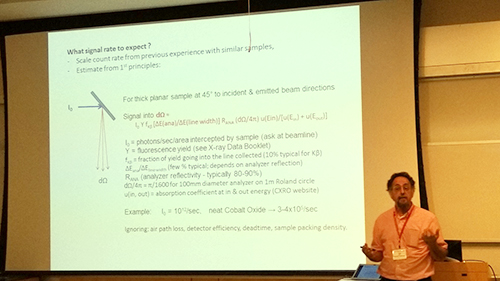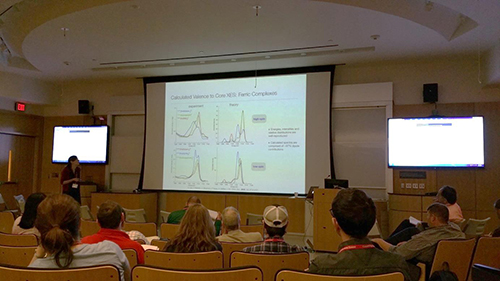X-RAY RUNS: Apply for Beamtime
2017 Nov 1 - Dec 21
2018 Feb 7 - Apr 3
2018 Proposal/BTR deadline: 12/1/17
2018 Apr 11 - Jun 4
2018 Proposal/BTR deadline: 2/1/18
This workshop, held Wednesday-Friday June 10-12, 2015 in association with the CHESS User Meeting, was designed to give a thorough, practical introduction on x-ray emission spectroscopy to researchers with little background in XES. Many more than the 25 maximum registered participants attended the first day talks. Wednesday morning was devoted to science and the afternoon to practical concepts. Thursday morning offered access to and expert help with simulation and data analysis software. Following lectures and classroom training, workshop participants shared 36 hours of measurement time, using DAVES at the C1 station.
A complete list of talk titles and abstracts is available at http://meetings.chess.cornell.edu/UserMeeting2015/agenda.html#xes.

Ken Finkelstein conducting the XES workshop.
Serena DeBeer (Max-Planck-Institut fuer Chemische Energiekonversion) opened the morning session with an overview on XES entitled "X-ray Emission Spectroscopy as a Probe of Catalysis". She pointed out why XES is a strong complement to traditional absorption spectroscopy, with information further enhanced by resonant measurements. Element specificity and opportunity to study samples in almost any environment make XES useful for studying countless questions in inorganic catalysis. She emphasized recent applications in biological and chemical catalysis, as well as future opportunities utilizing energy dispersive methods to follow dynamic processes.
Christopher Pollock (Pennsylvania State University) discussed "Biological Applications of X-ray Emission Spectroscopy: Structure and Mechanism of RNRs (Ribonucleotide Reductases)". He emphasized XES’ attractiveness for studying bioinorganic systems, where understanding function often requires detailed chemical knowledge of metal sites in these proteins. The Kβ mainline (3p→1s XES transition) is sensitive to metal spin state as well as metal-ligand covalency, while Valence-to-Core spectra contain information about ligand identity and molecular orbital electronic structure. The unique capability for simultaneous “two-color” XES was illustrated by a case study of the MnFe heterobimetallic active site of RNR from the pathogen Chlamydia trachomatis.
Young-June Kim (University of Toronto) described his studies of "Local moment physics in iron based superconductors", aimed at understanding the multiple orbital electronic structure of iron pnictides and chalcogenides. Because Fe Kβ XES is a fast, local probe that is bulk-sensitive and couples directly to d-electron moments it is particularly useful for studying paramagnetic phases of iron superconductors. His work on a wide range of Fe based superconductors shows local magnetic moments to be doping- and temperature-independent, while being extremely sensitive to structure.
One focus of Kyle Lancaster’s (Cornell University) work is "Elucidating Biological Energy Transduction from Ammonia". Nitrification, the oxidation of ammonia to nitrite and nitrate, is a key entry point for fixed nitrogen to return to the atmosphere. Tremendous economic loss in agriculture, and major ecological hazard are connected to nitrogenous eutrophication, but chemical steps in ammonia transformation to nitrite remain elusive. Insights on this problem inspire novel, green chemical methods for difficult bond activations and multi-electron transformation. His talk described construction of a recombinant expression system for functional nitrification metabolism that opens doors for genetic, chemical and spectroscopic studies of enzymes ammonia monooxygenase and cytochrome P460.

Submitted by: Ken Finkelstein, CHESS, Cornell University
07/13/2015
